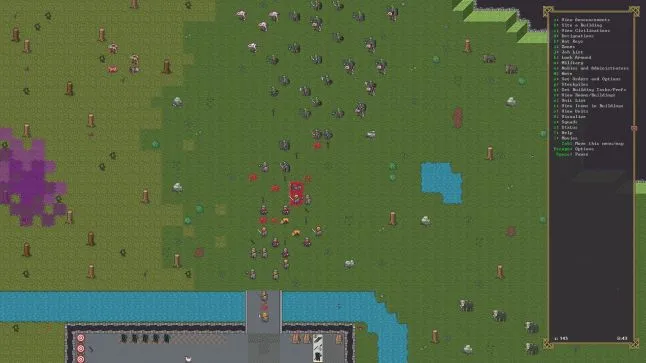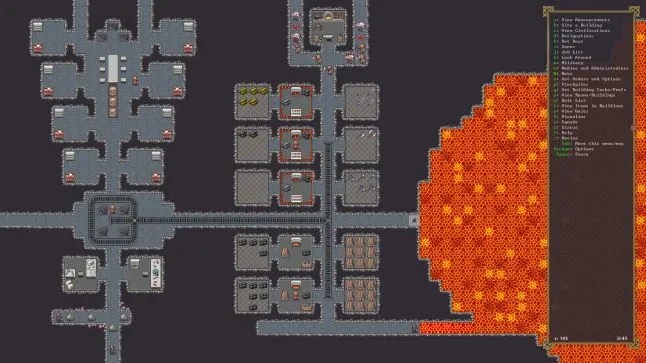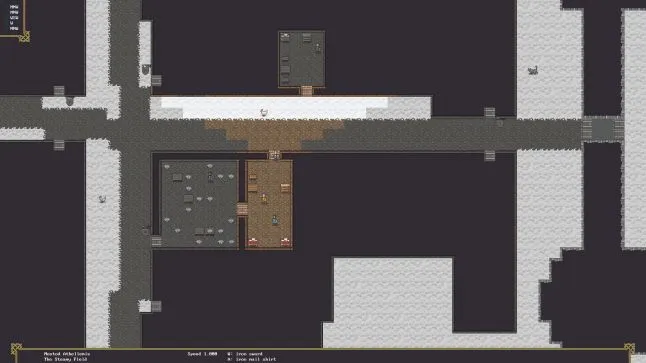I Want to Play Dwarf Fortress but I Cant Handle the Art
I of the best uses of a high-powered processor out at that place for entertainment purposes has long been Dwarf Fortress, the game that makes an entire globe out of ASCII characters, and will happily consume a gigabyte of your RAM and a good chunk of your processor cycles to bring it to life.
But unlike some other games, DF feels similar it needs everything it requires. Its exhaustive calculations create an entire world, with buildings, towns, merchants, rivers, volcanoes, monsters and, of grade, dwarves. If a single person created all these things it'd be an amazing achievement; Dwarf Fortress is a program that creates all those things on its own.
Creator Tarn Adams has agreed to answer some of our questions almost the creation of what is nonetheless, despite the presence of a number of imitators, an entirely unique game.
Gamasutra: I hear that Dwarf Fortress is coming to Steam and itch.io in a paid version with an easier interface. I heard the reason was business organization over possible time to come medical costs. Practice you notice it challenging staying afloat as an indie developer?
Adams: Yeah, a lot of piece of work goes into sticking around, and nigh everybody ends upwards needing to recollect of creative ways to keep to pay the hire and other basic expenses. And something could always come upward that is just too much to handle. We've been lucky so far, merely we've besides had to make some big shifts over the years, whether that's changing jobs or moving to Patreon, or to Steam and itch now, or making crayon drawings, which is somewhat far removed from our video games.
What does your day-to-day coding on Dwarf Fortress expect like? What languages do you utilize? What libraries? What IDE, if any? What does your dev machine expect like?
I simply work with a Windows 10 Toshiba laptop that isn't notable. I utilize some horrifying amalgam of C/C++ in MSVC Customs. I'm using OpenGL past itself for the legacy version, and SDL for the main one, with FMod for the sound. I don't employ anything else on Windows, just some of the headers that comes with MSVC (and before) that I've been using for decades. I'k not certain what'southward going on over in the Linux/Mac versions, since I don't develop regularly there.

Dwarf Fortress has been in evolution for almost 17 years now, and its codebase has got to be gigantic by this betoken. On my motorcar, making a globe just on default settings takes well over 1.two gigabytes of RAM. One trouble with mega-projects like DF is when the project gets too large to completely fit in your encephalon at one time. What strategies do you employ to keep it comprehensible and understandable enough to be worked on?
I have a consistent way of naming things, and I don't skimp on longer variable and function names so that everything is readable, even afterwards years abroad. Mostly, I'thousand mindful of beingness kinder to my hereafter cocky. My comments are all fabricated toward that purpose. "Find In Files" sees a lot of utilise. Merely there are times when I practice have to re-familiarize myself with what'southward going on, when an quondam system needs to be extended or a bug needs to be fixed, and it can accept an hour or more sometimes just to collect the pieces. That allows me to go out additional useful comments that I might not accept considered originally.
I remember that Threetoe (Tarn's partner in developing the game) writes stories that yous and then try to create a game engine in which they could occur. I still find this an inspiring manner to work. Are at that place any stories that you've had to reject every bit too difficult? Accept you ever plant the plot of one of them duplicated exactly inside the game?
Ha, I think they are all likewise difficult in some sense. Character motivations and goal-setting and etc. continue to lag far behind what they do in stories. It'southward still a useful process though, since there are some easier story-generating elements that stick out, and nosotros can likewise orbit the core character mechanics even if we never attain them.
Wikipedia reports that the game's version number (currently .44) indicates about how far along y'all are in completing the game (that is, 44%). What is up next for Dwarf Fortress? Exercise you feel whatsoever anticipation over what'south to come? What major features do you lot have left to implement?
I'one thousand finishing the villains release upwards over the next some months. That should be pretty entertaining. And then we're implementing the graphics and QoL stuff for the Steam/itch versions. Later on that, nosotros have some siege improvements and other piece of work before entering the Big Wait. The latter'll be the largest DF restructuring and addition ever, I'one thousand pretty certain, allowing united states to generate cosmos myths and have unabridged procedural magic systems, every bit well every bit having multiple view windows open in dissimilar parts of the world, etc. That'll be great. Then at that place's the belongings/law/customs/etc. release. After that, the order isn't set, but it'll involve the economy, boats, and other major missing components. At that place'due south a lot left to practice! We aren't even halfway to 1.0 yet. And 1.0 isn't really completing the game... nosotros only might not take a lot of time left by the time we get there.

In gaming, there's the balance between Narrative and Simulation, between the pre-written story most games take, and making a deep earth with a set of rules that can make many stories possible. Dwarf Fortress is ane of the greatest arguments towards Simulation, I would say. Do your characters, either during the game or in world gen, e'er do things that yous wouldn't await? Practise yous have any interesting/memorable examples to requite united states of america?
All the fourth dimension! In part, just because it's hard to keep all the rules in your caput when you are just messing around. All of my memorable stories are bugs though, since I hardly go a adventure to play the game for long at present, and so they are in one sense fundamentally uninteresting from an emergence standpoint (fifty-fifty if they are amusing.) The forums and streamers then forth take the practiced stories.
The line between micro and macro: why did you draw the line where you lot did, between what dwarves do for themselves and what yous direct the fortress to do?
It's a difficult rest and non e'er straightforward or consistent, but the current conception is that we want the thespian to be the "official volition of the fortress" while the dwarves also practice the autonomy they should be expected to take outside of their official duties. This allows them to exist actors in their own stories, which is a large part of where emergent narrative comes from. At the same time, the player should be able to direct the full general flow of their part of the game (this isn't crucial, actually, merely it's thought to be more fun than only watching a simulation, oft, ha ha.)
These two goals tin can run into each other, and often it relates to the histrion standing to accept fun with the game - for case, if an emergency lever really needs to be pulled, the job priority organisation can practically force a dwarf to go and practise it, autonomous or not, whether information technology feels similar they should really 'know' to practise it or non. We've had problems in the past adding too much bureaucracy, when nosotros had a quartermaster-type dwarf for instance handing out equipment. It was just as well slow and fiddly and prone to defoliation and bugginess. Thinking nearly what your individual game mechanics add to potential stories is important, and the quartermaster pretty much didn't have a role in that location.
What steps does the program become through in building a world?
Information technology allocates the retentivity for the map. So information technology chooses what sort of pole (eastward.k. north, due south) it is going to have (or respects the parameters fed by the thespian, throughout.) The basic map field values (elevation, rainfall, temperature, drainage, volcanism, wildness) are seeded along a grid of variable size, respecting various settings (oceans, isle sizes, other variances, etc.), and and then filled in fractally. The poles vary the temperature, and it selects some points for the highest peaks. Here it does a start pass to encounter how it is doing, and attempts to adapt some altitudes to fit the map within the desired parameters if it missed. The world can be rejected at this indicate if it is unfixable, and it tries again.
The starting time derived field, vegetation, is then set based on elevation, rainfall, temperature, etc., and information technology tests for biome rejections if the map'due south biomes don't satisfy the ranges set in the parameters. The mid-level elevations are smoothed at this point to brand more plains areas, and volcanoes are placed respecting the hot spots in the volcanism field.
And so we enter the erosion and river phase. Pocket-sized oceans are dried out, and information technology locates edges of mount sides where it can run test rivers. It besides places the camera on one of these and then the player can watch the process. Many fake rivers flow downward from these points, etching channels in the elevation field if they can't find a path to the sea. Extreme elevations differences are frequently smoothed here and so that everything isn't canyons. Ideally nosotros'd use mineral types for that, but we don't yet. Lakes are grown out at several points forth the rivers.

Elevations are smoothed again from the mountains down to the sea, and the peaks and volcanoes practise some local adjustments. At present that the elevations are finalized, it makes adjustments to rainfall based on rain shadows and orographic precipitation. Temperatures are reset based on elevation and rainfall and the dampening furnishings of forests, and it uses the new values to set the vegetation level one concluding fourth dimension. Salinity values are set up for the ocean and tiles neighboring the ocean.
Now that everything has settled downwardly, nosotros tin find the limits of the final biome regions and requite them names and their own identity. We also add the geological layers and the hole-and-corner layers here, though the geological stuff should really be earlier, as previously mentioned. There's a final verification process confronting the parameters here, to make sure it hasn't drifted too far afield from what the player wanted. One time that's done, it generates the initial wild fauna populations in each region, and sets some weather variables.
History itself tin can begin at this indicate. Civilizations and caves are placed. It's a bit complicated to go into what happens later on that, only the basic idea is that at that place's a giant zero-role player strategy game going on with somewhat loose turn rules and bad AI (only thousands of agents), and history is just a record of that. Procedurally generating stories by recording a log of a simulation is a valid enough arroyo, though it has drawbacks, of grade. Information technology's a lot of work, you need to do mail service-processing or investigation to find whatever good moments you'd similar to highlight, and if yous don't accept enough dynamics and mechanisms, the output can exist boring (in any number of means.)
One of my favorite facts nearly DF is how information technology doesn't have an explicit striking bespeak system at all, that everything about a graphic symbol's force and damage is part of a circuitous body part model. What advantages would you say such a system offers? If one did determine to create one, what obstacles would you warn them well-nigh?
It provides more than specific relatable story moments, lasting consequences, and provides more than consistency throughout the systems. It's possible to overdo it, and we have in some means, at least for now, while some of the fabric properties aren't used elsewhere. At that place are as well ways to soften the system, which y'all tin see in games that, for instance, accept a stamina/energy/hp pool, simply specific wounds occur as either criticals or the consequences of reaching nil or near zero in the pool. That tin can all work, depending on the game. For us, existence equally anti-numeric equally possible is ideal, since numbers usually make for poor stories.
What does the main game loop await similar?
In dwarf way, say. It starts with some announcement checks and considers autosaves, etc. A lot of the rest doesn't happen every tick. Every hundred ticks, for instance, it'll check job assignments and 'foreign moods.' Armies are moved on the world map. Every hundred ticks (staggered from the job check), information technology handles job applications by dwarves, a kind of invisible sale that it uses to manage the various competing priorities. Every 10 ticks information technology advances the seasons, which actually does all kinds of things with the atmospheric condition and map (both locally and in the world), and it likewise does a check for certain plot element advances (diplomats, sieges, etc.), and it checks whether your fort is yet live.
And so it hits some things that it does every tick. Fluids and other map tile information is advanced (though in that location are various optimizations here and so that not every tile is necessarily checked every turn, and there are various flags so that entire sections of the map can be skipped if nothing has happened.) Vermin running effectually are updated. Other 'events' on the map, similar active fires, are handled.
If a flag is set, wounded/thirsty/hungry dwarves that tin can't intendance for themselves get an update, and every and then oft, dead dwarves 'think' about their burial arrangements so that jobs can be set. Caged and chained creatures update their thoughts and situation periodically.
And so creatures exit the map if they are set to at the edges.
.jpg?width=828&quality=80&format=webply&disable=upscale)
Every fifty ticks, staggered from other updates, all of the taverns, temples, libraries, etc. go their information updated. Stockpiles, staggered on a different tick, besides piece of work this fashion. Similarly with storage job creation, though that process is complicated with various optimizations and lengthening ping times and so forth, and information technology's still slow, since at some point, 50000+ boulders volition cause problem.
Every thousand ticks, objects that have been marked for deletion and removed from the game are really deleted and freed. This happens more often with items, every fifty ticks, forth with a building utilize check (by and large updates for wells and another flags that often need checking.)
Nosotros hit another every tick update at this betoken. Projectiles are moved. Activities (which range from dances to martial training to storytelling) get updated equally needed. Dwarves and other creatures decide on and advance their immediate actions (motion to an next tile, working at a workshop, etc.) -- the bulk of their AI (outside of task selection) is here.
Every hundred ticks, items are rotted. Every tick, vegetation is avant-garde (though there are various staggers and flags here.) Building states are updated every tick as needed, and minecarts are moved. Hauling routes are advanced. Temperature is updated (there are various optimization flags here, but this is withal an unfortunately slow process.)
Finally the camera is updated to follow the creature you are following, if any.
Dwarf Fortress uses a filigree-based tilemap to depict its world, a uncomplicated, efficient and constructive means of representation. I discover that at that place's many ways a tile could exist drawn, based on whether it'due south a animate being, what the fauna is doing or feeling or if it's dead, whether there'due south more than than i thing in a tile, whether there'due south something above it, whether it's flowing water, or if it'southward entombed by rock. When DF gets down to deciding what to display in a tile, what does it exercise? How did you optimize information technology?
It's just a character (byte) with another few bytes of color, so it'south not expensive to just change your mind and replace a determination before the final print, rather than trying to make up one's mind all at in one case, and nigh tiles just want a single ground/wall character anyhow. It merely goes lesser to summit, 'top'-wise in some sense (that is creatures in a higher place items, items above the ground), replacing the decision at times. Still, in that location are various flags and helper arrays and so along, though more can be done. In that location is a lilliputian array of possible units to be printed at each tile, so that it can do a flipping blitheness that allows you to see every unit (over time) fifty-fifty when the game is paused.
Source: https://www.gamedeveloper.com/design/q-a-dissecting-the-development-of-i-dwarf-fortress-i-with-creator-tarn-adams
0 Response to "I Want to Play Dwarf Fortress but I Cant Handle the Art"
Post a Comment